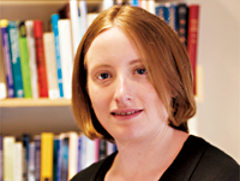MIT Assistant Professor Noelle Selin Answers Three Questions on Energy Policy
Noelle Selin’s professional interests have always centered on the intersection of policy and the environment. During her undergraduate training at Harvard University, she pursued an interdisciplinary major in environmental science and public policy. She also worked on toxic chemicals issues for the US Environmental Protection Agency and spent a year as a Fulbright fellow with the European Environment Agency. But to really make an impact, Selin felt she needed deeper knowledge. After earning her PhD in atmospheric chemistry from Harvard University, she found the perfect fit performing interdisciplinary research at MIT. From engaging with state and national air pollution regulators to briefing delegates during international negotiations, Selin constantly designs her research to be responsive to the needs of policy makers and strives to communicate her results effectively. She is currently part of the Stanford-affiliated Leopold Leadership Program for mid-career academics, where she is honing her skills in designing and communicating research related to the environment and sustainability.
MIT Energy Initiative: You’re currently working on a MITEI seed grant project. What are your goals in this research?

Selin: Recently, there have been a lot of air quality improvements that may have altered the background chemistry of the atmosphere. If we don’t account for those changes when evaluating current and future regulations, we may end up with regulations that are less effective than predicted. To help in such analyses, Susan Solomon of earth, atmospheric, and planetary sciences, John Reilly of the MIT Joint Program on the Science and Policy of Global Change, and I are creating a dynamic model that can quickly show which pollutants to reduce to get the biggest benefits. We’re beginning our research by looking at the US, but the model could easily be applied to other regions, and we hope to use it to examine air quality in the context of climate policy.
MIT Energy Initiative: What’s been involved in making your model a useful tool for policy makers?
Selin: The real challenge for all modelers in this area is to represent the complexity of the atmosphere and to take uncertainties into account in a rigorous way, while also obtaining results that are simple and specific enough to help policy makers. We’re designing the model to confront this tension without making it too complicated and time-consuming to run. We’re doing so by taking key elements from different complex models and deciding what’s needed to approach the actual probelm in the environment. Then we’re piecing all the most useful information together into one model.
MIT Energy Initiative: What methods do you use to teach your students how to make their research relevant to policy?
Selin: I encourage students to think critically about how to bring knowledge to action by engaging them in current policy discussions. For example, during last year’s Independent Activities Period [at MIT], I took a group of students to the international mercury negotiations in Geneva, Switzerland. Each student was assigned a mercury-related topic and asked to blog about the latest developments in that area. This fall, my class is taking a virtual field trip via webcast to the climate negotiations [at the Conference of the Parties] in Warsaw, Poland, and the class assignments are blog posts where students give scientific assessments, issue summaries, and updates on the negotiations. My goal is to get students to think about what science is relevant to policy development and how to communicate it, so they can be engaged in the policy-making process.
Excerpted from New faculty strengthen, broaden MIT’s energy expertise which appeared in the Autumn 2013 issue of Energy Futures, the magazine of the MIT Energy Initiative.
Keep Reading
Most Popular
Large language models can do jaw-dropping things. But nobody knows exactly why.
And that's a problem. Figuring it out is one of the biggest scientific puzzles of our time and a crucial step towards controlling more powerful future models.
How scientists traced a mysterious covid case back to six toilets
When wastewater surveillance turns into a hunt for a single infected individual, the ethics get tricky.
The problem with plug-in hybrids? Their drivers.
Plug-in hybrids are often sold as a transition to EVs, but new data from Europe shows we’re still underestimating the emissions they produce.
Stay connected
Get the latest updates from
MIT Technology Review
Discover special offers, top stories, upcoming events, and more.